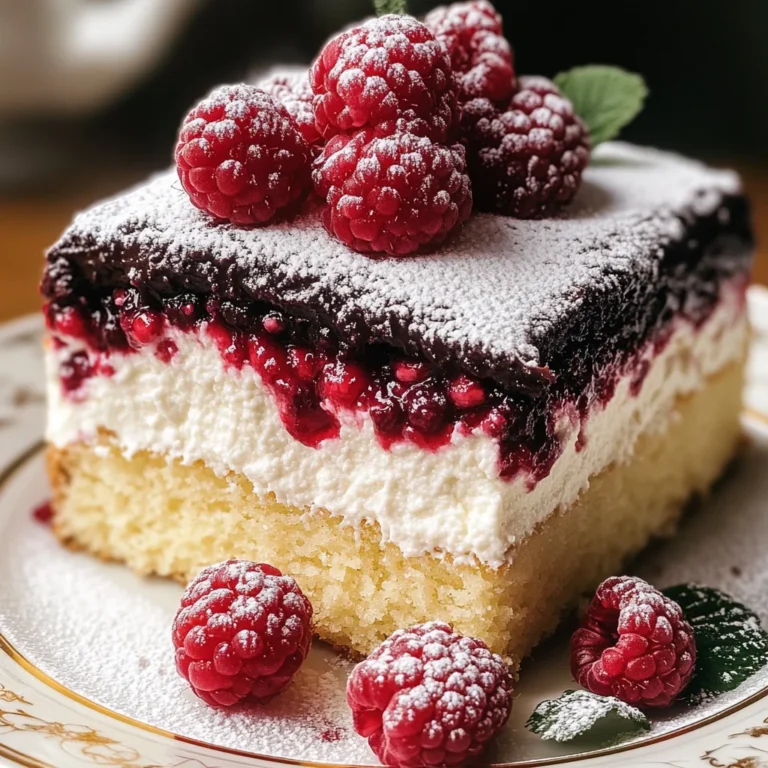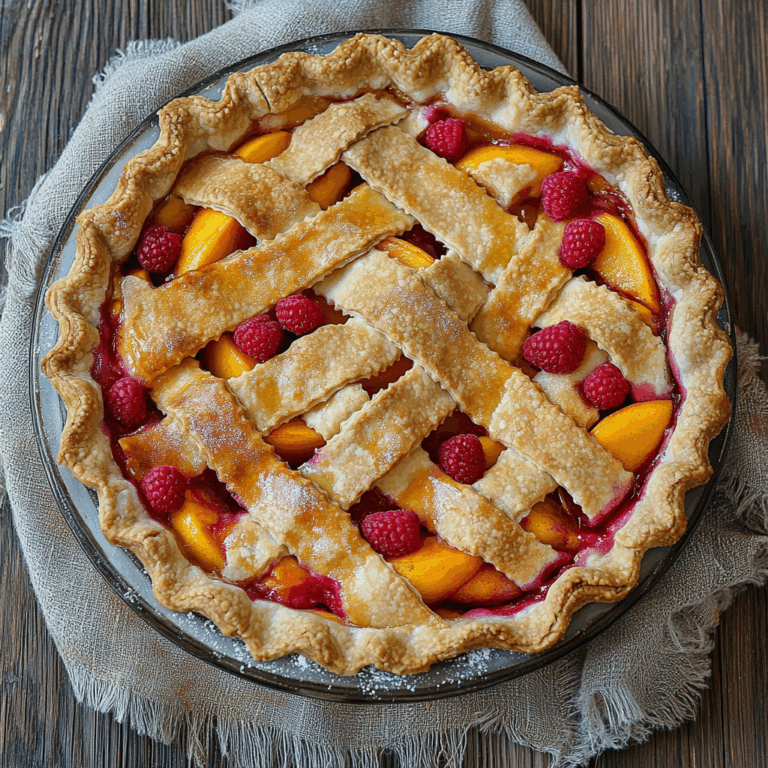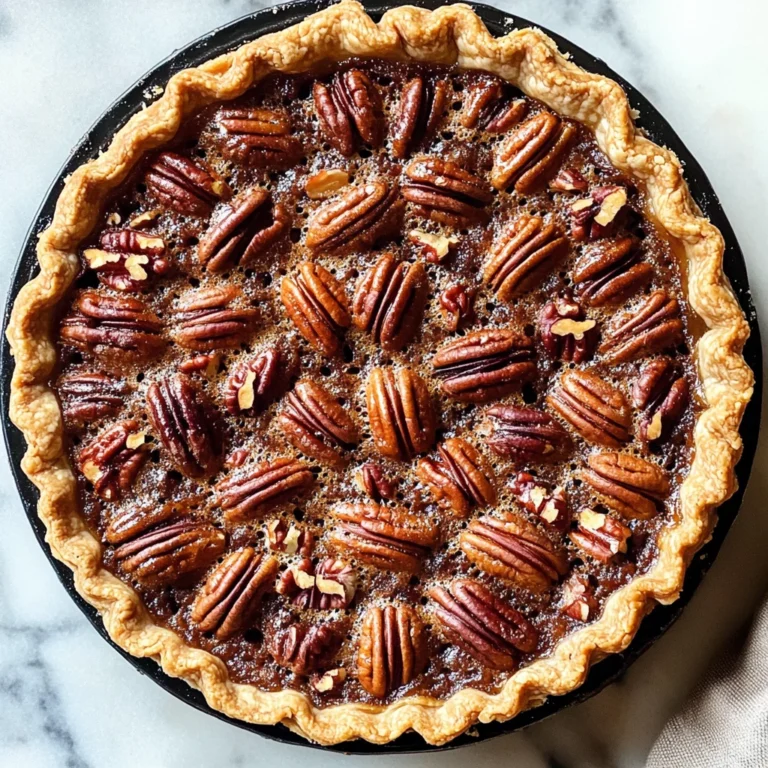Greek Custard Pie
If you want a delightful dessert that combines creamy custard with crispy phyllo pastry, then Greek Custard Pie is the perfect choice. This traditional Greek dessert, known as galaktoboureko, is ideal for celebrations, family gatherings, or simply as a sweet treat to enjoy at home. Its unique texture and rich flavor will surely impress everyone at the table.
Why You’ll Love This Recipe
- Irresistible Flavor: The combination of creamy custard and sweet syrup creates a delicious contrast that is hard to resist.
- Easy to Make: With a straightforward set of instructions, even novice bakers can create this stunning dessert.
- Perfect for Any Occasion: Whether it’s a holiday or a casual dinner party, this pie brings joy to any gathering.
- Versatile Serving Options: Serve it warm or chilled; either way, it tastes fantastic!
- Impressive Presentation: The golden-brown phyllo layers make for an eye-catching dessert that will wow your guests.
Tools and Preparation
To prepare Greek Custard Pie successfully, you’ll need some essential tools. Having the right equipment simplifies the cooking process and ensures great results.
Essential Tools and Equipment
- Mixing bowls
- Baking dish
- Whisk
- Saucepan
- Pastry brush
Importance of Each Tool
- Mixing bowls: These are vital for combining ingredients smoothly without mess.
- Baking dish: A good quality baking dish ensures even cooking and browning of the pie.
- Whisk: This tool is essential for achieving a light and fluffy custard.
- Pastry brush: Use this for evenly applying melted butter on phyllo layers, ensuring they turn crispy and golden.
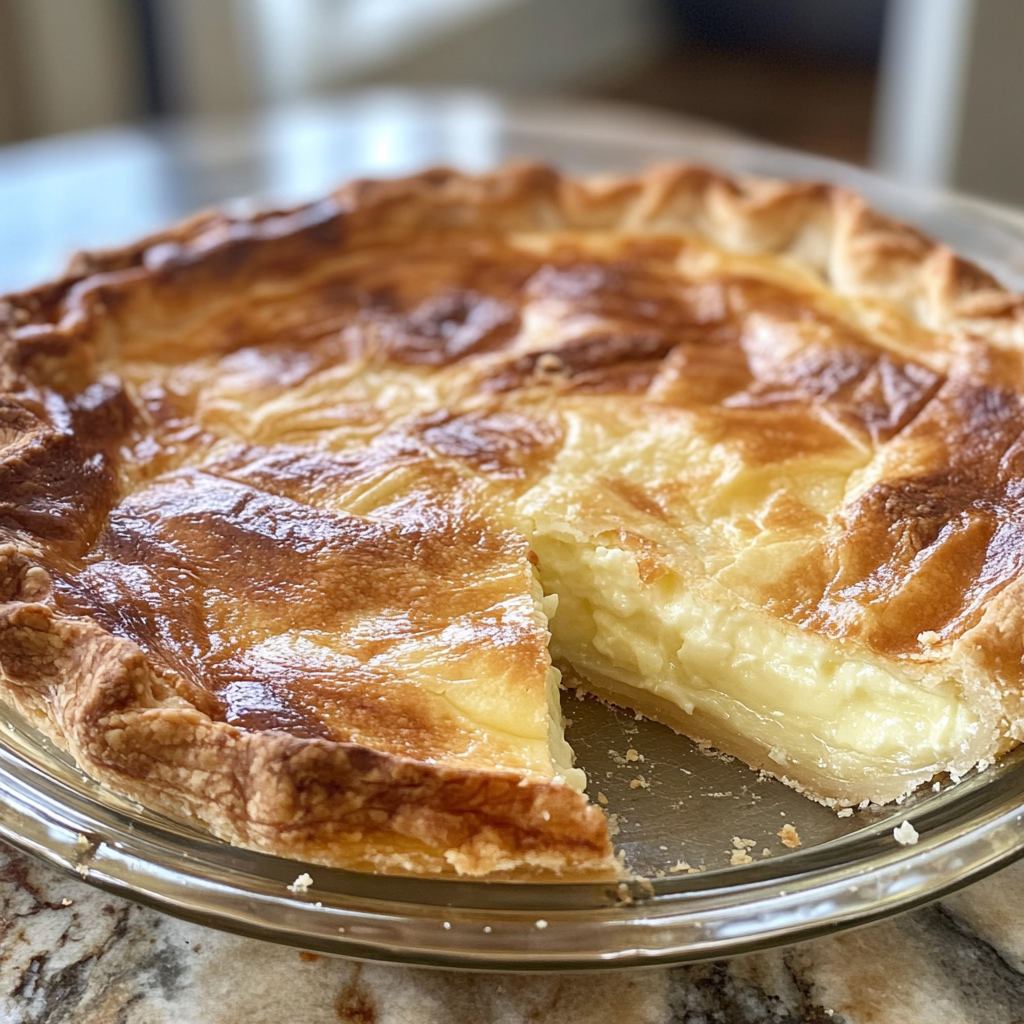
Ingredients
For the Syrup:
- 3½ cups (700g) granulated sugar
- 2 cups (500ml) water
- 1 cinnamon stick
- 1 lemon, squeezed (not the juice. Keep the juice for future use)
For the Phyllo Layers:
- 1 package phyllo pastry, 12 sheets
- 1 cup (240g) butter, melted, at room temperature
For the Custard Filling:
- 8 cups (2 liters) whole milk, fresh
- 1 cup (200g) fine semolina
- 1 cup (200g) granulated sugar
- 4 eggs
- 2 egg yolks
- 1 teaspoon vanilla extract
- 1 lemon zest
- 1 cinnamon stick
- ¼ cup (60g) butter, cold
How to Make Greek Custard Pie
Step 1: Prepare the Syrup
Start by making the syrup. In a saucepan over medium heat:
1. Combine water and sugar.
2. Add one cinnamon stick and bring to a boil.
3. Allow it to simmer for about 10 minutes until slightly thickened.
4. Remove from heat and let it cool while you prepare the pie.
Step 2: Prepare the Phyllo Layers
- Preheat your oven to 350°F (175°C).
- Brush your baking dish with melted butter.
- Lay down one sheet of phyllo pastry in the dish and brush it lightly with more melted butter.
- Repeat this process for about half of the phyllo sheets.
Step 3: Make the Custard Filling
In a large mixing bowl:
1. Combine milk and semolina in a saucepan over medium heat.
2. Stir continuously until it begins to thicken.
3. In another bowl, whisk together eggs, sugar, vanilla extract, lemon zest, and remaining cinnamon stick.
4. Gradually pour in some hot milk mixture into your egg mixture while whisking continuously to temper the eggs.
5. Return everything back into the saucepan and cook until fully thickened.
Step 4: Assemble and Bake
- Pour the custard filling over the layered phyllo in your baking dish.
- Top with remaining phyllo sheets, brushing each layer with butter as before.
- Bake in preheated oven for about 60 minutes or until golden brown.
Step 5: Final Touches
Once baked:
1. Remove from oven and immediately pour cooled syrup over hot pie evenly.
2. Allow it to rest so that it absorbs all that sweet syrup goodness before serving.
Enjoy your homemade Greek Custard Pie, a delightful treat that’s sure to please!
How to Serve Greek Custard Pie
Serving Greek Custard Pie, or galaktoboureko, can elevate any gathering with its delightful flavors and textures. Here are some creative serving suggestions to enhance your dessert experience.
Pair with Fresh Fruits
- Berries – Serve with a mix of fresh strawberries, blueberries, and raspberries for a tart contrast.
- Citrus Slices – Orange or lemon slices can add a refreshing zing that complements the sweetness.
Enjoy with Whipped Cream
- Lightly Sweetened Cream – A dollop of whipped cream can create a creamy texture that pairs well with the custard.
- Flavored Creams – Try adding vanilla or citrus zest to the whipped cream for an extra flavor boost.
Accompany with Coffee or Tea
- Espresso – The boldness of espresso balances the sweetness of the pie perfectly.
- Herbal Tea – A cup of chamomile or mint tea can provide a soothing finish to your meal.
How to Perfect Greek Custard Pie
Creating the perfect Greek Custard Pie requires attention to detail. Here are some tips to help you achieve delicious results.
- Use Fresh Ingredients – Fresh milk and eggs will yield a richer flavor in your custard.
- Keep Phyllo Pastry Covered – To prevent drying out, cover unused phyllo sheets with a damp cloth while assembling.
- Cool Before Serving – Allow the pie to cool completely before serving; this helps set the custard properly.
- Drizzle Syrup Generously – Make sure to pour enough syrup over the pie for maximum flavor absorption.
Best Side Dishes for Greek Custard Pie
Greek Custard Pie is versatile and can be enjoyed alongside various side dishes that enhance its flavors. Here are some delightful options.
- Greek Salad – A refreshing mix of cucumbers, tomatoes, olives, and feta cheese adds a light contrast.
- Spanakopita – These savory spinach and feta pies offer a delicious balance to the sweet custard.
- Roasted Vegetables – Seasonal roasted veggies bring earthy flavors that complement the dessert’s sweetness.
- Tzatziki Sauce – This cool yogurt sauce provides a refreshing dip that contrasts nicely with the pie.
- Baklava Bites – Mini versions of this nutty pastry pair well for those who love sweets.
- Pistachio Nuts – Lightly salted pistachios add crunch and richness alongside each slice of pie.
Common Mistakes to Avoid
Making Greek custard pie can be a delightful experience, but there are a few common pitfalls to watch out for.
- Bold preparation: Failing to prepare your ingredients ahead of time can lead to mistakes in measurements. Always measure and set out your ingredients before you start cooking.
- Bold phyllo handling: Not using the phyllo pastry correctly can result in a soggy pie. Make sure to keep the sheets covered with a damp cloth while working to prevent them from drying out.
- Bold syrup consistency: Skipping the syrup stage or not cooking it long enough can affect the sweetness. Ensure you let the syrup simmer until it’s slightly thickened.
- Bold oven temperature: Baking at the wrong temperature can burn the top or leave the custard undercooked. Preheat your oven properly and check it with an oven thermometer if needed.
- Bold cooling time: Cutting into the pie too soon may cause it to fall apart. Allow your Greek custard pie to cool completely before serving for the best texture.
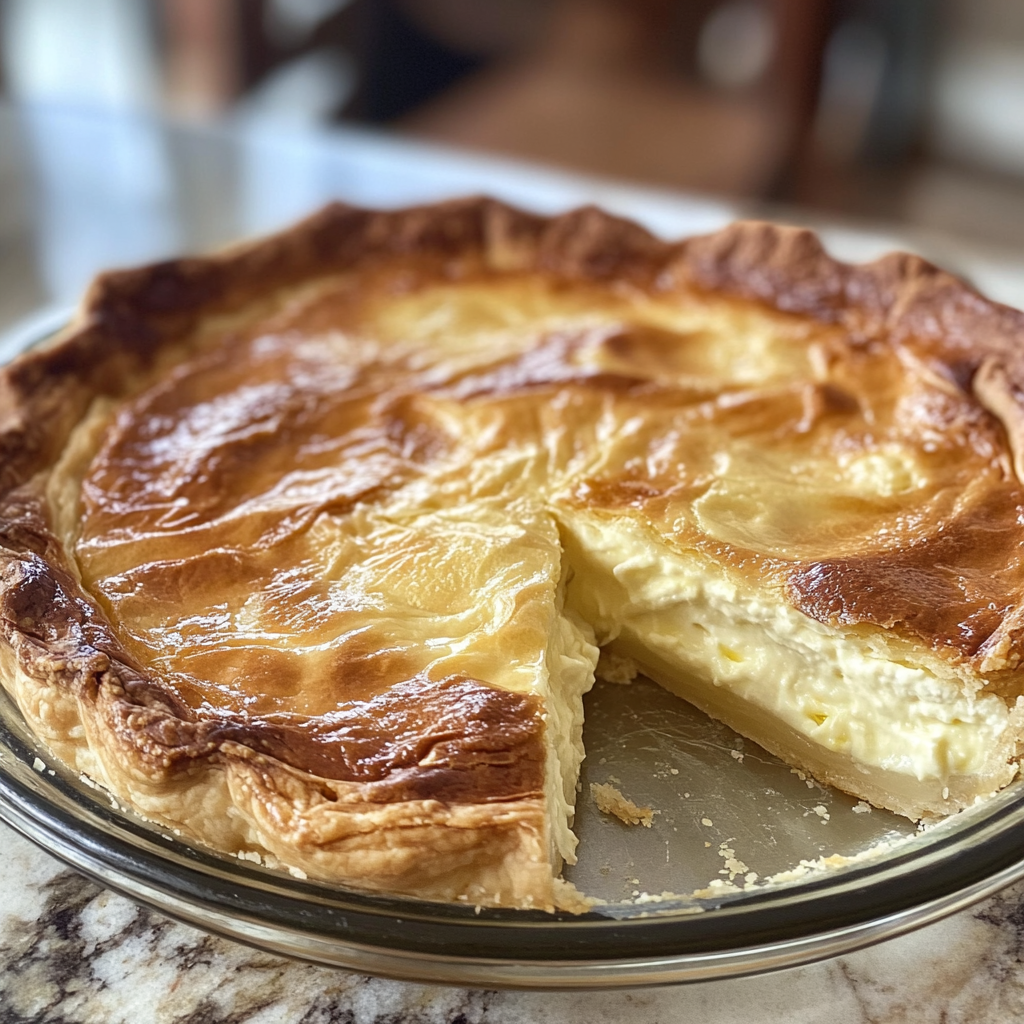
Storage & Reheating Instructions
Refrigerator Storage
- Store in an airtight container for up to 3 days.
- Keep it covered with plastic wrap if not using a container.
Freezing Greek Custard Pie
- Wrap tightly in plastic wrap and then foil, storing for up to 2 months.
- Thaw in the refrigerator overnight before reheating.
Reheating Greek Custard Pie
- Oven: Preheat to 350°F (175°C) and heat for about 15-20 minutes until warm throughout.
- Microwave: Use medium power for 1-2 minutes, checking every 30 seconds.
- Stovetop: Place in a skillet over low heat, covering with a lid, and warm for about 10 minutes.
Frequently Asked Questions
Here are some common questions about making Greek custard pie.
What is Greek Custard Pie?
Greek custard pie, known as galaktoboureko, is a dessert made of layers of phyllo pastry filled with semolina-based custard and topped with syrup.
Can I customize my Greek Custard Pie?
Yes! You can experiment with flavors by adding orange zest or different extracts like almond or lemon.
How do I make my custard thicker?
To achieve a thicker custard, ensure you’re using fine semolina and cook it long enough on low heat while continuously stirring.
Can I use dairy alternatives for this recipe?
Absolutely! You can substitute whole milk with almond milk or another plant-based milk; just be mindful of texture changes.
How should I serve Greek Custard Pie?
This dessert is best served cold or at room temperature, garnished with crushed pistachios or almonds for added texture and flavor.
Final Thoughts
Greek custard pie is not only delicious but also versatile. You can customize it with various flavors and toppings to suit your taste. Don’t hesitate to try this delightful dessert; it’s sure to impress family and friends!
Greek Custard Pie
Indulge in the delightful layers of Greek Custard Pie, a traditional dessert known as galaktoboureko. This exquisite treat features crispy phyllo pastry enveloping a luscious semolina-based custard, all drizzled with a fragrant syrup of sugar and lemon. Perfect for celebrations or cozy family gatherings, this pie combines irresistible flavors and textures that will impress your guests. Whether served warm or chilled, each slice promises to be a heavenly experience.
- Prep Time: 30 minutes
- Cook Time: 60 minutes
- Total Time: 1 hour 30 minutes
- Yield: Approximately 10 servings 1x
- Category: Dessert
- Method: Baking
- Cuisine: Greek
Ingredients
- 3½ cups (700g) granulated sugar
- 2 cups (500ml) water
- 1 cinnamon stick
- 1 lemon, squeezed (not the juice. Keep the juice for future use)
- 1 package phyllo pastry, 12 sheets
- 1 cup (240g) butter, melted, at room temperature
- 8 cups (2 liters) whole milk, fresh
- 1 cup (200g) fine semolina
- 1 cup (200g) granulated sugar
- 4 eggs
- 2 egg yolks
- 1 teaspoon vanilla extract
- 1 lemon zest
- 1 cinnamon stick
- ¼ cup (60g) butter, cold
Instructions
- Start by making the syrup. In a saucepan over medium heat, combine water and sugar.
- Add one cinnamon stick and bring to a boil.
- Allow it to simmer for about 10 minutes until slightly thickened.
- Remove from heat and let it cool while you prepare the pie.
- Preheat your oven to 350°F (175°C).
- Brush your baking dish with melted butter.
- Lay down one sheet of phyllo pastry in the dish and brush it lightly with more melted butter.
- Repeat this process for about half of the phyllo sheets.
- In a large mixing bowl, combine milk and semolina in a saucepan over medium heat.
- Stir continuously until it begins to thicken.
- In another bowl, whisk together eggs, sugar, vanilla extract, lemon zest, and remaining cinnamon stick.
- Gradually pour in some hot milk mixture into your egg mixture while whisking continuously to temper the eggs.
- Return everything back into the saucepan and cook until fully thickened.
- Pour the custard filling over the layered phyllo in your baking dish.
- Top with remaining phyllo sheets, brushing each layer with butter as before.
- Bake in preheated oven for about 60 minutes or until golden brown.
- Once baked, remove from oven and immediately pour cooled syrup over hot pie evenly.
- Allow it to rest so that it absorbs all that sweet syrup goodness before serving.
Nutrition
- Serving Size: 1 serving
- Calories: 296
- Sugar: 30g
- Sodium: 75mg
- Fat: 12g
- Saturated Fat: 7g
- Unsaturated Fat: 4g
- Trans Fat: 0g
- Carbohydrates: 41g
- Fiber: 1g
- Protein: 5g
- Cholesterol: 78mg


